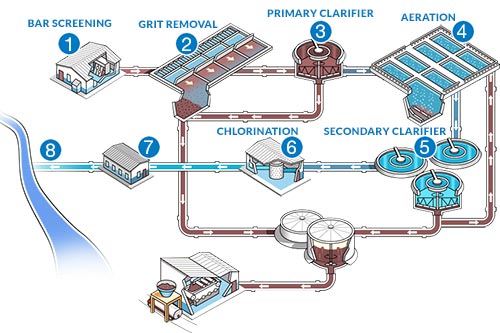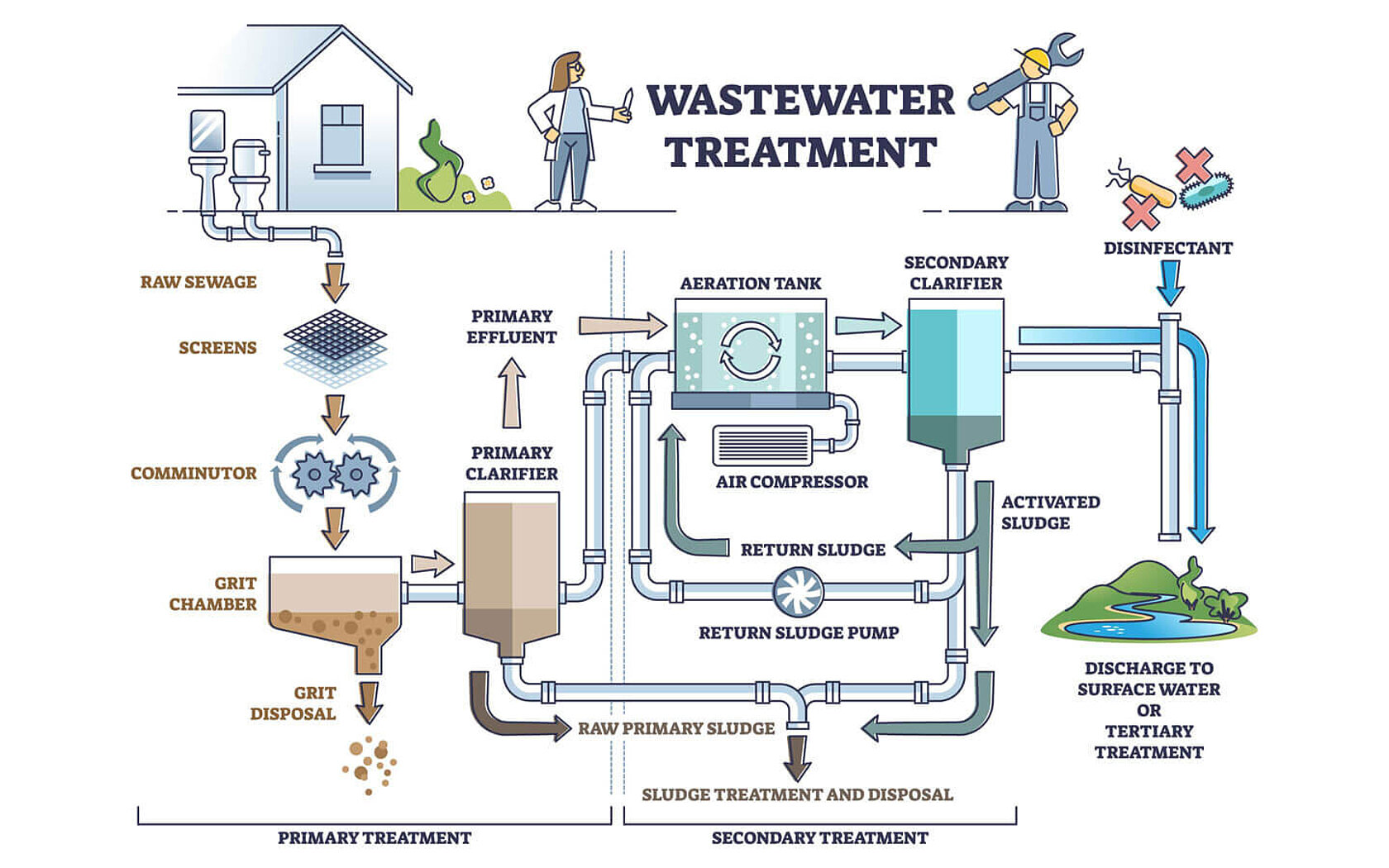A Beginner’s Guide to Wastewater System
Explore the Various Kinds of Wastewater System Suitable for Diverse Demands
The exploration of wastewater systems exposes a range of options tailored to satisfy different environmental and operational needs. Centralized treatment systems serve metropolitan facilities effectively, while decentralized choices provide country neighborhoods with sustainable options. Industrial applications demand specialized strategies, concentrating on pre-treatment and recycling. The surge of ingenious innovations, such as membrane bioreactors, hints at a transformative shift toward source performance. Understanding these varied systems not only highlights their private merits however additionally questions regarding their long-lasting implications for sustainability and infrastructure durability. What, after that, are one of the most important difficulties and opportunities within this advancing landscape?
Summary of Wastewater Equipment
Wastewater systems play an essential function in managing the water that is utilized and disposed of by industries, houses, and districts. These systems are developed to gather, treat, and discharge wastewater securely, ensuring environmental protection and public health and wellness. The complexity of wastewater systems arises from the varied resources of wastewater, which can include residential sewer, industrial effluents, and stormwater overflow.
The essential elements of wastewater systems consist of collection networks, treatment centers, and disposal methods. Collection networks contain pipes and pumping stations that transport wastewater from its resource to treatment facilities. Treatment centers after that process the wastewater with physical, chemical, and biological techniques to remove pollutants before it is released back right into the environment or reused for different applications.
The design and procedure of wastewater systems have to consider variables such as population density, regulatory requirements, and ecological influence. In addition, advancements in technology are causing the growth of more lasting and reliable wastewater administration methods. On the whole, reliable wastewater systems are important for keeping water high quality, conserving water resources, and advertising public wellness in neighborhoods around the world.

Centralized Treatment Solutions
Central treatment systems are essential parts of modern wastewater management, successfully taking care of huge quantities of wastewater generated by city populations and industrial activities. These systems commonly are composed of a network of collection pipes, treatment plants, and discharge electrical outlets, designed to deal with wastewater prior to it is launched back right into the environment.
Centralized systems are most ideal for densely inhabited areas where the focus of wastewater requires a large response. The primary benefit of such systems is their capacity to give uniform therapy criteria, making certain that effluent meets regulative demands prior to discharge. Additionally, centralized therapy centers frequently incorporate innovative innovations, such as biological therapy procedures, purification, and disinfection approaches, improving the top quality of cured water.
Operational performance is an additional key benefit, as economies of scale permit minimized per-unit treatment costs contrasted to decentralized alternatives - Wastewater System. Central systems also encounter difficulties, consisting of the demand for significant framework financial investment, potential ecological effects from large discharge volumes, and vulnerability to system failures that can interfere with solution for entire communities.
Decentralized Treatment Alternatives
Decentralized treatment alternatives use a versatile and sustainable option to streamlined systems, specifically in country or much less densely inhabited areas. These systems are created to deal with wastewater near the source of generation, lowering the demand for considerable piping infrastructure and decreasing transportation prices. Common decentralized innovations include septic tanks, built wetlands, and oxygenated lagoons, each tailored to satisfy details local conditions and treatment requirements.
Septic tanks, as an example, are commonly used for individual houses, properly dividing solids and liquids while allowing all-natural filtering through the dirt. Built wetlands imitate natural processes, supplying efficient therapy through vegetation and microbial task, making them an ecologically friendly option. Oxygenated shallows utilize oygenation to promote microbial degradation of raw material, appropriate for bigger areas or collections of homes.
Decentralized systems also give strength against infrastructure failures commonly connected with central systems, allowing communities to preserve wastewater administration also throughout unfavorable conditions. Additionally, they can be integrated with water reuse techniques, promoting sustainability and decreasing freshwater need. Thus, decentralized treatment options provide a viable remedy for varied wastewater monitoring requires, enhancing environmental management and community wellness.
Industrial Wastewater Solutions
Efficient monitoring of commercial wastewater is essential for lessening the ecological effect of ensuring and producing processes compliance with regulatory criteria. Industries produce varying sorts of wastewater, commonly containing unsafe chemicals, hefty metals, and organic toxins, necessitating customized treatment options.
One common strategy to industrial wastewater management includes pre-treatment processes, which might consist of neutralization, screening, and sedimentation to get rid of huge solids and adjust pH degrees. Following pre-treatment, organic therapy methods such as triggered sludge or biofilm activators can efficiently decrease natural material and nutrients. For details sectors, advanced oxidation or membrane layer filtering methods may be employed to resolve more complicated pollutants.

Compliance with regional, state, and federal regulations is extremely important throughout this process. Normal surveillance and reporting are important to ensure that treatment systems operate efficiently and satisfy the called for requirements. In recap, calculated preparation and robust treatment innovations are crucial in taking care of commercial wastewater efficiently, guarding both the environment and public health.
Sustainable and Innovative Technologies
Developments in lasting and ingenious technologies are improving the landscape of wastewater monitoring, structure upon pop over here the fundamental methods developed in industrial wastewater options. Arising techniques such as membrane layer bioreactors (MBRs) important link and advanced oxidation procedures are improving treatment efficiency while reducing environmental impact. MBRs incorporate biological therapy and membrane layer purification, enabling the effective removal of contaminants and generating high-grade effluent suitable for various reuse applications.
In addition, the integration of wise innovations, consisting of Web of Points (IoT) sensors and artificial knowledge, enables real-time tracking and optimization of wastewater treatment procedures. These innovations promote aggressive administration, minimizing operational expenses and energy usage. The fostering of decentralized wastewater treatment systems encourages areas to manage their sources effectively, promoting sustainability at the regional level.
Additionally, making use of biotechnological techniques, such as microbial fuel cells, not only treats wastewater yet also generates renewable resource. These innovations underscore the change towards a round economic climate, where wastewater is considered as a resource instead than a responsibility. By embracing these ingenious and sustainable modern technologies, the wastewater sector can dramatically add to environmental defense and resilience against future challenges.
Conclusion
In summary, wastewater systems encompass a variety of remedies tailored to meet distinct demands throughout metropolitan, rural, and commercial contexts. Jointly, these varied systems navigate to this site play a vital function in effective wastewater management and environmental security.
The complexity of wastewater systems emerges from the varied sources of wastewater, which can consist of domestic sewer, commercial effluents, and stormwater overflow.
The essential components of wastewater systems include collection networks, treatment centers, and disposal approaches (Wastewater System).Decentralized systems also offer durability versus infrastructure failures often connected with central systems, allowing areas to preserve wastewater monitoring even throughout damaging problems.Advancements in cutting-edge and sustainable modern technologies are reshaping the landscape of wastewater monitoring, structure upon the foundational practices developed in industrial wastewater services. The fostering of decentralized wastewater therapy systems encourages areas to handle their sources properly, promoting sustainability at the regional level